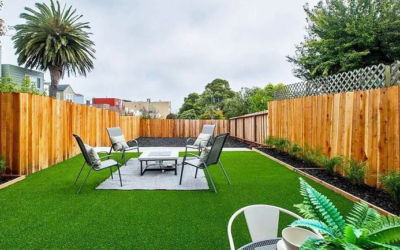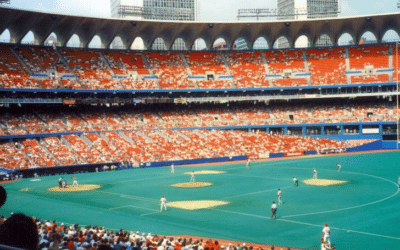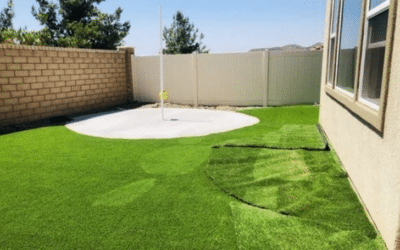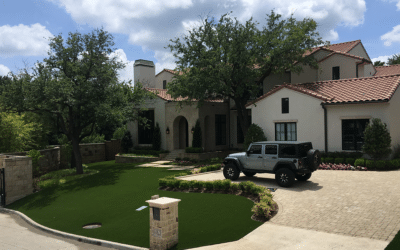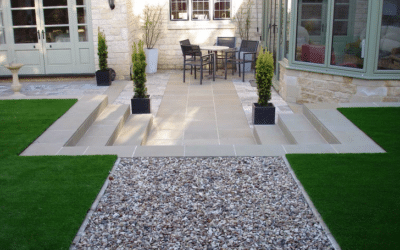The campus of the University of Texas at Austin has been home to the Longhorns football team for a century but it hasn’t been slow in looking to the future.
The UT stadium, known as the Texas Memorial Stadium, Darrell K Royal Memorial Stadium or simply the DKR has used artificial turf for over half a century. In fact, it helped set the trend for switching to artificial turf that many other schools and sports stadiums have followed.
Sports stadium owners, players, and commentators are increasingly weighing up the pros and cons of artificial turf vs. natural grass playing fields in terms of costs, performance, and maintenance requirements.
Let’s take a look at what you need to know about the turf at the UT Stadium and the more general use of turf at sports stadiums…
Does the UT Stadium Have Grass or Turf?

The UT stadium currently uses artificial turf but the word on the grapevine is that grass may be reintroduced as the playing surface by 2026.
The most recent turf field was installed in 2021, the latest in a long line of artificial turf pitches used at the stadium since 1969.
However, Texas Athletic Director, Chris Del Conte recently declared an intention to restore grass to the Austin American-Statesman, claiming, “I just think grass is where football is meant to be played.”
Del Conte is in a slight minority when compared with the U.S. pro football world. In the NFL, 15 turf fields are currently used by 17 teams and 13 teams and stadiums use real grass. Two teams use a “hybrid” field, which is made from natural grass reinforced with synthetic fibers.
History of The UT Stadium
In the early 1920s, the former UT athletics director and a group of student leaders presented a proposal for the wooden bleachers of Clark Field to be replaced with a concrete stadium.
After the plans were approved, the first incarnation of the UT stadium in 1924 had a capacity of 27,000. Compare that with an official capacity today of around 100,000 and a record crowd of 105,213 (set in 2022) and you have an idea of the stadium’s immense growth over the years.

The Texas Memorial Stadium was originally named in honor of Texans serving in World War I and, even today, retains a close connection with Texan war veterans. One game per year is dedicated to their memory.
The legendary exploits of football coach Darrell K Royal, who led Texas to three national championships and eleven Southwest Conference titles, were honored when the stadium was named after him in 1996.
Although the Longhorns have joined the Southeastern Conference (SEC) for the 2024-25 academic season, the UT stadium was the largest of the Big 12 Conference stadiums. The stadium is also the largest facility in the southwest, the seventh-largest stadium in the U.S., and the ninth-largest stadium in the world!
Originally designed as a dual-purpose stadium with an athletics track surrounding the football field, the track was removed in 1999 and the venue is now used exclusively for football games and special events.
Today, the UT stadium remains at the forefront of college football in the U.S. and is still considered a top-class facility that has seen multiple upgrades and enhancements over the years.
What Type of Artificial Turf Is Used At The UT Stadium?
In 2021, a new playing surface was installed at the UT Stadium, the third FieldTurf installation since 2009. That was the year when the natural grass field was converted back to artificial turf for the second time in the university’s history.

The stadium first switched to artificial grass in 1969, when the first AstroTurf designs started to become popular. However, the Longhorns returned to artificial grass in 1996.
In 2009, the UT’s problems with the grass playing surface led to FieldTurf stepping in to install a new artificial turf surface again.
FieldTurf manufactures high-quality artificial grass designed for use on sports fields and installed in over 20,000 locations worldwide. It’s fair to say that it’s one of the most popular choices for elite sports stadiums in the U.S. In Texas alone, FieldTurf is used at the University of Houston, the University of North Texas, Texas Tech University, and Texas State University.
The UT Stadium uses FieldTurf CORE, the company’s leading system. It employs a multi-lay, dual-polymer fiber engineered for a realistic, textured, grass-like shape with optimal durability and resilience.
Drew Martin, Executive Senior Associate Athletics Director for External Affairs, had this to say about the playing turf at UT University:
“We’ve played on FieldTurf for over a decade…the work they’ve done on product development and safety research set them apart for us.”
Plans for Grass At The UT Stadium
According to reports in the Austin press, the UT Stadium is set to switch again to real grass. The present artificial turf playing surface installed in 2021 will be ripped up and replaced with grass by 2026 if the intentions of the Texas Athletic Director come to fruition.

The main reason for sticking with artificial grass over the past 15 years has been the wear and tear factor. The surface inside the UT stadium endures both band and team practices, which would quickly wear down a grass field.
The proposed switch back to grass appears to be mainly due to a general preference for real grass.
However, because practice fields need to remain artificial to withstand the wear and tear of multiple practice sessions, the timing of the proposed switch is expected to coincide with the construction of new practice fields to the south of UT’s Moncrief-Neuhaus Athletic Center.
The safety element of playing surfaces is a critical consideration for sports stadiums but it is not a simple “black and white” issue. There are many gray areas.
One study using NCAA injury surveillance data from 2004-14 concluded that playing football on artificial surfaces increases the incidence of some lower body injuries. Some players have come out and voiced opinions against turf.
On the other hand, artificial grass has many fans and, to date, experts in the field are reluctant to draw firm conclusions from the data available.
Much depends on the turf type used, the installation, the local climate, and other factors. Falls may be harder on artificial turf but this may be counterbalanced by the fact that artificial turf generally provides a flatter surface with fewer imperfections and trip hazards. Besides, the best artificial grass is rigorously tested for safety.

The Grass vs Turf Debate
The switch from a real grass field to artificial turf at the UT Stadium in 1969, back to grass in 1996, and back again to turf in 2009 is symptomatic of the dilemmas facing many sports stadiums around the world.
Being tasked with balancing the needs of players and spectators, while also trying to run a profitable business can be challenging. Many heated discussions have addressed which surface is best for sports fields – turf or grass.
The best artificial turf is ultra-low-maintenance, remains usable all year, can withstand considerable wear and tear, and looks immaculate with virtually no effort.
From a purely financial perspective, artificial turf is a cost-effective option, despite upfront costs often exceeding $1 million when installed from scratch (around half of that if you’re replacing one turf field with another).
However, due to the lack of maintenance required, the higher installation costs are generally paid back within a few years. This perhaps explains the growing trend towards artificial turf and away from grass.

Although most college school teams in the SEC currently play their home games on grass, that’s not the case generally across the U.S. Almost three-quarters of the 133 schools that currently compete in the top tier of NCAA football use turf instead of grass for home games and the majority of Big 12 teams now play on turf.
In addition to these large sports projects, many parks, recreational areas, playgrounds, dog parks, and backyard sports fields have installed artificial grass surfaces in recent years.
On the other hand, some players and coaches express a preference for real grass because of how it looks and feels during games and practices.
The differences between real grass and artificial grass are narrowing as technology improves the appearance, texture, and performance of the artificial variety so that it more closely resembles real grass.
Pros and Cons of Artificial Turf At Sports Stadiums
Let’s summarize the pros and cons of real grass vs artificial grass below:
Main Pros of Artificial Turf
- Very low maintenance
- Highly cost-effective
- Natural look and appearance all year round
- Weather resistant (rain, sun, ice and snow)
- Increased playing time (fewer weather interruptions)
- Highly durable
- Drains well
- Little water required
- Few chemicals used
- No mud
Main Cons of Artificial Turf
- Higher installation price
- Some players prefer natural grass
- Some negative stigma remains about turf
- Requires infill, which may contain chemicals
- Hotter than grass
Main Pros of Real Grass
- Looks natural and lush when well-kept
- Gives out oxygen and filters pollution
- Absorbs heat well
- Absorbs moderate rainfall well
- Generally good traction
- Cushioned feel
Main Cons of Real Grass
- Sodding required
- High maintenance with mowing, edging, aeration, weed control, watering, etc.
- Sprinkler system and irrigation required
- Compaction and bare spots may occur
- Muddy in wet weather
- Heavy rainfall may lead to standing water
- May be damaged by icy conditions

Pro-Style Turf For Sports Fields
Whether the UT Stadium sticks with artificial turf or switches back to grass in 2026, the grass vs turf debate is likely to rumble on with sports fields.
There’s no doubt that the low maintenance/water usage, an immaculate appearance all year and cost-effectiveness make high-quality, durable synthetic turf attractive for high-use commercial areas such as sports fields.
If you’re considering artificial turf for football, soccer or any other indoor or outdoor sport, discuss your options with an artificial grass professional.

